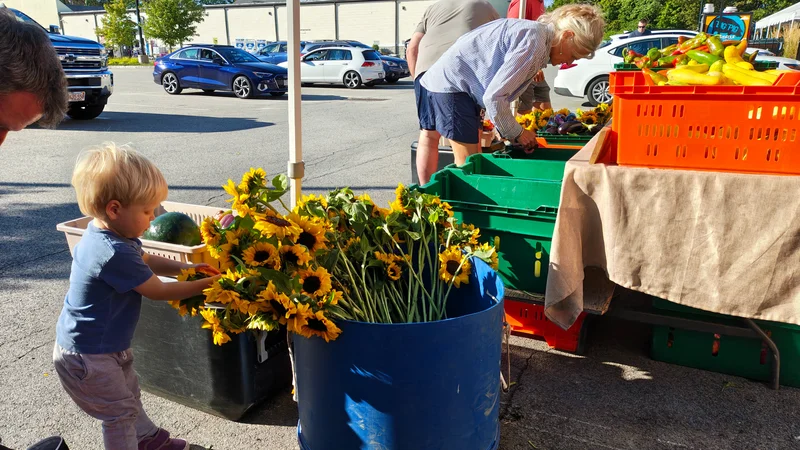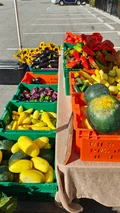TL;DR
Today we harvested sungold cherry tomatoes, processed drying onions, I weeded carrots and helped with CSA distribution. The joy on people’s faces when they pick up their veg is kind of worth all the work to get it to them.
I Turned a Corner on Toil
I opted to do hoeing while everyone else was gone from the farm today. Later on, I realized that I wasn’t unhappy doing the work like I have been in the past. I knew what I had to do and more importantly knew the outcomes when the work was done well. We also don’t always have the luxury of time or the right timing to weed, but we always harvest whether there are weeds or not, and doing so with less weeds involved is almost always easier. So, yeah, I was kind of happy to be weeding today.
In my previous tech career, I stumbled across a book that named ‘toil’ as an enemy of the Site Reliability Engineer (SRE). “Manual, repetitive, tactical, devoid of enduring value…” or somesuch, usually associated with anything that you can’t write some code to automate and never look back at it again. From a purely digital, automation-crazed perspective, this definition might make sense since you can copy and paste anything and it costs you nothing but time to do so. People who are used to this way of thinking would naturally then consider most farm work ‘toil’ because many things have to be done over and over again by hand.
The word ‘toil’ has already been formally defined: “hard and continuous work; exhausting labor or effort.” How very dare some tech nerds take an already defined term and just redefine it to fit their own perspective. Granted, I’m personal acquaintances with some of the authors and they’re all very smart. And to create a completely new term in the 21st century is idiotic, right? Nevermind SREs, DevOps, ‘fully remote’, ‘burnout’, and basically every phrase from Gen Alpha. Sometimes in the search for creative thinking, all sense of creativity is lost.
But the use of the term should fit more than just the act of doing something over and over again. It should also encompass the joy and satisfaction that comes from the outcomes of the work. Nothing meaningful in human history ever happened without significant effort and hard work. As I watched a little kid picking out sunflowers with their dad at the CSA pickup tent today, I realized that the work is easier when you know the kind of joy and health it brings others.

Some Joy Takes Longer to Find
The onions we planted all April, sometimes in the snow, were harvested about a month or so ago and have been drying in the shed in preparation for including in the CSA. These are drying onions and have a very different lifecycle than the short-crop early fresh onions we planted and harvested in about two months during the summer. Some things take longer than others.
Having already harvested carrots many days this year, knowing the difference in effort it takes when there are more or less weeds, seeing the amount that gets sacrificed to pests and rot, but still getting what we need is all a part of the joy in farming. It’s not a ‘loss’ when you meet your goals, and it’s a shame to let greed for every little scrap ruin the bigger picture.
I used to work for companies that would make hand-over-fist profits while at the same time squeezing any room for improvement out of CapEs and OpEx budgets to keep spend as low as possible. From a board room perspective, this might make someone not ask more questions than what’s already on deck. From the perspective of people doing the work, getting squeezed, and deeply invested in the sweat equity of the labor, it just looks like greed to make so much profit while under-investing in ground level practicalities. Employees are often treated to an all-company fly over of sales and projection numbers, but are rarely ever shown the harsh reality of how small increases in spend accumulate rapidly over time and undermine income streams.
Running a small farm isn’t all that different…except that the people involved are intentionally so and toil is an expected input to producing joy as an outcome.
LLMs Don’t Eradicate the Toil of Meaningful Writing
There is no learning that happens when you ask an LLM to write your content for you, save that maybe you spend your time on tweaking prompts and looking for non-human word tripe that leaks in occasionally. Personally, I’d rather write my own content and learn from the process than publish fake and insightless content because, while this blog is public and under Creative Commons, my primary audience is me (future products) in the future so I have to be honest.
The first thing I knew about this blog was that I wanted to learn how to effectively use LLMs to analyze and summarize text…because doing so every day after also doing the human writing part seemed like ‘toil’ in the tech sense. I have yet to ‘harvest’ the benefits of using LLMs for this purpose, but I anticipate that a similar joy of all this blog writing and coding and process design will follow once I start working on aggregates like custom embeddings or specialized pre-trained models specifically for organic agriculture and farming.
For today at least, another summary goes in to the queue for future processing.
AI Summary from Field Notes
Consolidated Summary
Main Themes
- Farm Operations: Harvesting, drying, and preparing crops (tomatoes, onions, carrots).
- Logistics & Distribution: Packing, delivering, and managing CSA pickups.
- Seasonal Challenges: Balancing weeding with harvesting, limited staff, and timing constraints.
- Customer Interaction: Ensuring customer satisfaction through CSA shares and market engagement.
- Weed Management: Addressing persistent weeds (e.g., purslane) and their impact on crop quality.
Key Activities
- Washed bins for CSA pickup.
- Harvested Sun Gold cherry tomatoes.
- Dried onion tops and removed unnecessary peelings.
- Packed truck for deliveries to Gloucester and Ipswich.
- Weeded carrots, focusing on purslane removal.
- Set up and sold CSA shares at True North.
- Delivered orders and interacted with customers.
- Organized CSA pickup stand and unpacked supplies.
New Experiences
- CSA Distribution: First time participating in distribution pickups or market tents.
- Purslane Management: Dealing with abundant weeds requiring specialized weeding techniques.
- Timing Trade-offs: Balancing weeding with harvesting due to limited staff.
Questions for Future Research
- How to effectively manage purslane and other weeds without harming crops?
- How to optimize staff workflows to reduce time spent on weeding while maintaining crop quality?
- What are the ideal conditions for drying onions to ensure low moisture content?
- How to enhance customer satisfaction during CSA pickups and market events?
- How does timing of weeding and harvesting affect crop health and yield?
Suggested Actions
- Improve Weeding Techniques: Develop efficient strategies (e.g., timing, tools) to reduce labor.
- Staff Training: Educate team on proper onion drying and crop handling.
- Expand Distribution: Explore additional CSA pickups or market events to boost engagement.
- Track Weeding Impact: Monitor weed abundance and crop growth to inform future practices.
- Streamline Communication: Clarify roles to optimize packing, weeding, and delivery tasks.
Part 1
Main Themes
- Farm Operations and Produce Management: Harvesting, drying, and preparing crops (tomatoes, onions, carrots).
- Logistics and Distribution: Packing, delivering, and setting up CSA pickup stands.
- Seasonal and Time Constraints: Balancing harvesting with weeding, limited staff, and timing.
- Customer Interaction: Satisfaction with CSA shares and the importance of distributing produce.
- Challenges in Farm Work: Dealing with weeds (e.g., purslane), precision in weeding, and resource limitations.
Activities Performed by the Intern
- Washed bins for CSA pickup.
- Checked and prepared tomatoes (Sun Gold cherry tomatoes).
- Harvested Sun Gold cherry tomatoes with two others.
- Dried onion tops and removed unnecessary peelings for distribution.
- Packed the truck for deliveries to Gloucester and Ipswich.
- Weeded carrots, focusing on removing purslane and preserving carrot sprouts.
- Set up and sold CSA shares at True North.
- Delivered orders and interacted with customers.
- Unpacked and organized the CSA pickup stand.
New Things Not Yet Encountered
- CSA Distribution: The intern had not previously participated in distribution pickups or farm tent events.
- Purslane Management: The abundance of purslane in fields required specialized weeding techniques.
- Timing Trade-offs: The intern noted the challenge of balancing weeding with harvesting due to limited staff.
Questions and Future Research Areas
- Weed Management: How can purslane and other weeds be effectively controlled without compromising crop yield?
- Staff Efficiency: How can the farm optimize workflows to reduce time spent on weeding while maintaining crop quality?
- Drying Onion Process: What are the optimal conditions (e.g., humidity, ventilation) for drying onions to ensure low moisture content?
- Customer Satisfaction: How can the farm improve interactions with customers to enhance the CSA experience?
- Seasonal Timing: How does the timing of weeding and harvesting affect crop health and yield in the final season?
Suggested Actions
- Implement Weeding Techniques: Develop a more efficient weeding strategy (e.g., using tools or timing) to reduce labor.
- Train Staff on Crop Care: Educate team members on the differences between drying onions and green onions to ensure proper handling.
- Expand Distribution Efforts: Explore opportunities for additional CSA pickups or market events to diversify customer engagement.
- Document Weeding Challenges: Track weed abundance and crop growth to inform future planting or management strategies.
- Improve Communication: Clarify roles and responsibilities among staff to streamline tasks like packing, weeding, and distribution.
[end of post]
Enjoy Reading This Article?
Here are some more articles you might like to read next:





